During a power outage, I rely on a mix of portable options like kerosene heaters, canned heat devices, and fuel-powered stoves to stay warm. Devices such as the Sengoku kerosene heater or a compact Kero stove provide reliable heat without electricity, while fuel canisters and portable power stations add flexibility. Proper ventilation and safety checks are essential. If you want to discover more effective solutions and safety tips, keep exploring these options further.
Key Takeaways
- Use fuel-based heaters like kerosene or propane models with proper ventilation for reliable heat during power outages.
- Portable canned heat devices and self-powered heaters offer power-free warmth for indoor and outdoor use.
- Long-lasting kerosene heaters can provide extended heating, suitable for continuous emergency needs during prolonged outages.
- Radiant heaters such as kerosene or wick-based models deliver direct heat without electricity, ideal for small spaces.
- Combine traditional fuel heaters with backup power stations or battery-powered electric heaters for flexible emergency heating options.
VESTA Self-Powered Camping Heater & Stove

If you’re looking for a reliable, portable heating and cooking solution that doesn’t depend on electricity, the VESTA Self-Powered Camping Heater & Stove is an excellent choice. It combines space heating and cooking in a compact, lightweight design, weighing just 7.6 pounds. Operated solely on canned heat, it’s perfect for indoor and outdoor use, heating up to 200 sq ft. It produces minimal smoke and fumes, making it safe for indoor environments with proper ventilation. With included canned heat, it provides long-lasting warmth and cooking capability, making it ideal for camping, emergencies, or off-grid situations. Its simple setup and durability make it a dependable choice.
Best For: outdoor enthusiasts, emergency preparedness kits, and off-grid living requiring portable, reliable heating and cooking without electricity.
Pros:
- Self-powered, no electricity needed, operates solely on canned heat
- Compact and lightweight at just 7.6 pounds for easy portability
- Emits minimal smoke and fumes, making it safe for indoor use with proper ventilation
Cons:
- Limited to heating up to 200 sq ft, not suitable for large spaces
- Requires canned heat (included) which needs to be replenished for extended use
- May freeze at temperatures below 16°F (-8°C), affecting shelf life and performance
EF ECOFLOW Portable Power Station River 2 Max 500
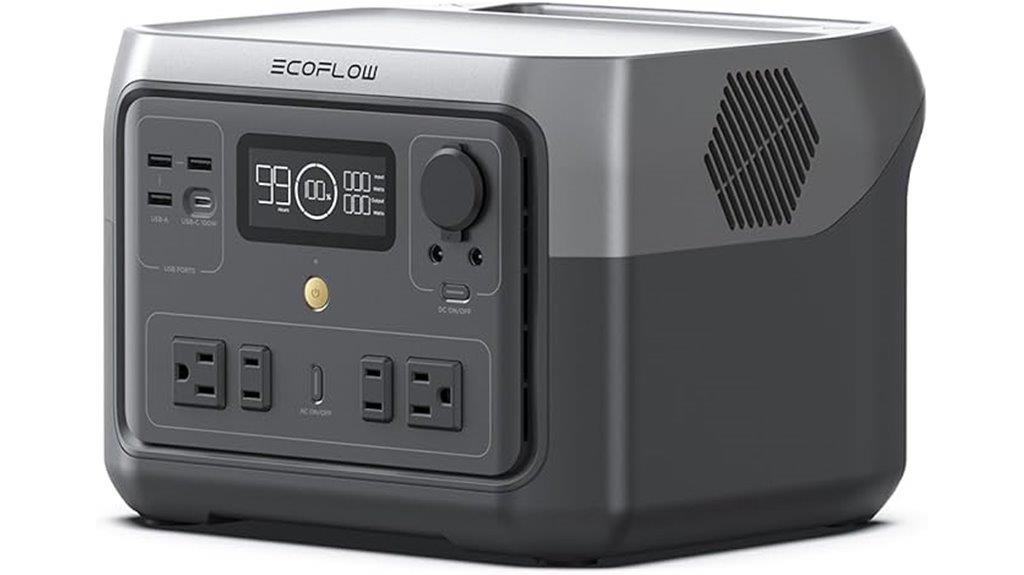
The EF ECOFLOW Portable Power Station River 2 Max 500 stands out as an ideal solution for those seeking reliable backup power during emergencies, especially when conventional electricity sources are unavailable. It recharges quickly—just an hour with EcoFlow’s X-Stream technology or in 2.3 hours via solar, supporting clean energy. With a 1000W output capacity, it can power multiple essential appliances simultaneously. Its LiFePO4 batteries ensure over 10 years of use, and its multiple ports—including AC and USB-C—cover all device needs. Weighing only 13.3 pounds, it’s portable enough for outdoor or home backup, backed by a 5-year warranty for peace of mind.
Best For: outdoor enthusiasts, RV travelers, and homeowners seeking reliable, portable backup power during emergencies or outdoor activities.
Pros:
- Fast recharge time of just 1 hour with EcoFlow’s X-Stream technology, ensuring quick readiness.
- Supports up to 1000W output, powering multiple devices simultaneously without overload.
- Long-lasting LiFePO4 batteries with over 10 years of operational life and comprehensive BMS protection.
Cons:
- Limited to a 500Wh capacity, which may require multiple charges for extended use.
- Slightly heavier compared to smaller portable power options at 13.3 pounds.
- May be more expensive than basic portable power solutions due to advanced features and warranty.
Sengoku Indoor & Outdoor Kerosene Heater (23,500 BTU)

When power outages strike, having a reliable heating source that doesn’t rely on electricity becomes essential. The Sengoku Indoor & Outdoor Kerosene Heater offers 23,500 BTU, capable of warming spaces up to 1,000 square feet. Its portable design makes it suitable for indoor and outdoor use, from garages to patios. It runs for about 12 hours on 1.9 gallons of kerosene, ensuring sustained warmth. Safety features like automatic shut-off, tip-over switch, and protective grills make it secure to operate. Plus, it’s easy to use with a push-button start and included siphon pump. It’s a versatile, dependable option during power outages.
Best For: individuals seeking a portable, reliable kerosene heater for use during power outages or in hard-to-heat spaces both indoors and outdoors.
Pros:
- Provides powerful 23,500 BTU heating capacity suitable for up to 1,000 sq ft
- Operates for approximately 12 hours on 1.9 gallons of kerosene, ensuring long-lasting warmth
- Features safety mechanisms like automatic shut-off, tip-over switch, and protective grills for secure use
Cons:
- Requires handling and storage of kerosene, which may be hazardous for some users
- Heavier and larger than electric heaters, potentially less convenient for portability in tight spaces
- No electric power needed, but reliance on kerosene may involve more maintenance and refueling
Ontel Handy Heater Turbo Wall Outlet Space Heater

The Ontel Handy Heater Turbo Wall Outlet Space Heater is an ideal emergency heating option because it plugs directly into a standard outlet, saving space and eliminating the need for extension cords or bulky heaters during power outages. Its compact, lightweight design makes it perfect for bedrooms, offices, or garages, while its 800-watt ceramic element heats up to 250 square feet efficiently. The adjustable thermostat and 12-hour programmable timer provide consistent comfort, and advanced ceramic technology helps maintain air moisture, preventing dryness. With auto shut-off and stay-cool housing, it’s a safe, quiet, and convenient solution for small-space heating when power is out.
Best For: those seeking a compact, space-saving, and safe heating solution for small rooms, offices, or during power outages.
Pros:
- Space-efficient plug-in wall outlet design eliminates clutter and saves space.
- Heats up to 250 sq ft quickly with adjustable thermostat and programmable timer.
- Advanced ceramic technology maintains air moisture, ensuring comfort without dryness.
Cons:
- Limited to small spaces up to 250 sq ft; not suitable for large areas.
- May need to be plugged directly into outlets, which could block other devices.
- As a portable heater, it may not be suitable for continuous, heavy-duty heating needs.
Sengoku Indoor & Outdoor Kerosene Heater (10,000 BTU)

If you need reliable heat during power outages, the Sengoku Indoor & Outdoor Kerosene Heater stands out with its portability and long-lasting fuel capacity. It delivers 10,000 BTU, heating up to 400 square feet efficiently for up to 14 hours on a single fill. Perfect for home, garage, basement, or camping, it’s cordless and easy to operate with push-button start, EZ flame adjuster, and automatic ignition. Its safety features include an automatic shut-off, tip-over switch, and protective grills. Weighing only 20 pounds, it’s lightweight enough to move where needed. Overall, it’s a versatile, safe, and dependable heating solution during emergencies.
Best For: those seeking a portable, reliable heating solution for large indoor or outdoor spaces during power outages or in emergency situations.
Pros:
- Delivers up to 14 hours of heat on a single fuel fill, ideal for long-lasting warmth.
- Equipped with advanced safety features like automatic shut-off, tip-over switch, and safety guards for children and pets.
- Lightweight and cordless at only 20 pounds, making it easy to move and position as needed.
Cons:
- Uses kerosene fuel, which requires proper storage and handling.
- May produce fumes, so ventilation is necessary when used indoors.
- Limited to heating areas up to approximately 400 sq ft, which may not suffice for very large spaces.
4400-Watt Portable Inverter Generator

A 4400-watt portable inverter generator provides reliable power during emergencies, making it an excellent choice for home heating without electricity. With a rated power of 3600W and a 1.6-gallon fuel tank, it can run up to 11 hours at 25% load, ensuring long-lasting operation. Its quiet operation at 76 dB makes it suitable for residential areas. Weighing just over 61 pounds and compact in size, it’s easy to transport and store. Equipped with safety features like carbon monoxide detection, low oil shutdown, and overload protection, it’s a dependable and safe option for powering small space heaters or essential appliances during outages.
Best For: homeowners, campers, and outdoor enthusiasts needing reliable, quiet backup power for essential appliances and small space heaters during outages or outdoor activities.
Pros:
- Long runtime of up to 11 hours on a 1.6-gallon tank at 25% load
- Quiet operation at 76 dB, suitable for residential and outdoor environments
- Equipped with safety features including CO detection, low oil shutdown, and overload protection
Cons:
- Weighs over 61 pounds, which may be heavy for some users to transport frequently
- Compact size may limit the power output for larger appliances
- Operating noise level, while quiet for a generator, may still be noticeable in very quiet settings
EF ECOFLOW Portable Power Station DELTA 3 Max

When preparing for power outages that threaten your home heating, the EF ECOFLOW Portable Power Station DELTA 3 Max stands out as an ideal solution. It features a robust 2048Wh LiFePO4 battery and a 3400W X-Boost output, capable of powering most household appliances, including fridges and microwaves. Its rapid charging—getting from 0 to 80% in just over an hour—is perfect for emergencies. Lightweight and durable, it supports solar charging and offers quiet operation with seamless power transfer, protecting sensitive electronics. With remote management via the EcoFlow app, it’s a reliable and versatile backup option to keep your home warm during outages.
Best For: homeowners seeking a reliable, portable backup power solution for emergencies, outdoor adventures, or off-grid living.
Pros:
- High-capacity 2048Wh LiFePO4 battery provides long-lasting power for multiple devices
- Rapid charging from 0 to 80% in just over an hour ensures quick readiness during emergencies
- Supports solar charging and features seamless power transfer with quiet operation, ideal for sensitive electronics
Cons:
- Weighs approximately 44.8 pounds, which may be heavy for some portability needs
- Higher upfront cost compared to smaller or less powerful portable generators
- Limited to three output outlets, which might be insufficient for large-scale power needs
Ontel Handy Heater Deluxe with Remote
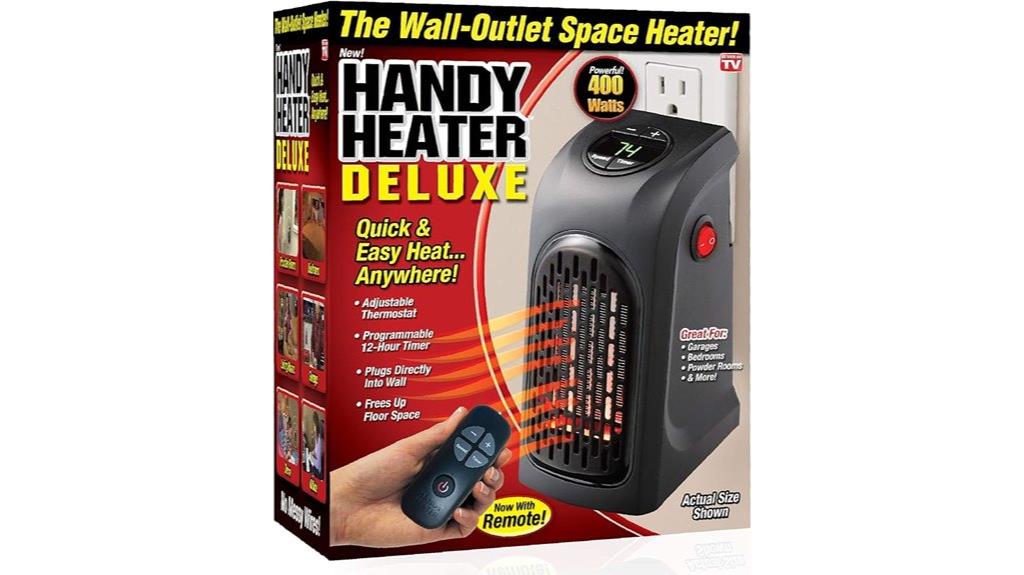
The Ontel Handy Heater Deluxe with Remote stands out as an ideal emergency heating option for those seeking quick, targeted warmth without relying on power outlets or complex setups. Its 400-watt ceramic design makes it perfect for small and large spaces like bedrooms, garages, or bathrooms. Simply plug it into any outlet for immediate heat, and use the remote to adjust temperature and set a 12-hour timer. The digital display keeps you informed, while the cool-to-touch exterior guarantees safe handling. Compact and portable, it’s a convenient solution to stay warm during power outages, offering reliable comfort in an emergency.
Best For: individuals seeking a portable, quick-heating solution for small to large spaces during emergencies or everyday use.
Pros:
- Compact and portable design for easy transport and space-saving placement
- Remote control and digital display for effortless temperature and timer adjustments
- Safe cool-to-touch exterior suitable for use around children and pets
Cons:
- Limited to 400-watt heating, which may be insufficient for large or very cold spaces
- Requires an electrical outlet for operation, limiting placement options in some scenarios
- May not provide as much heat as larger or more powerful heating units
Kero World 10,000 BTU Kerosene Wick Heater

If you’re looking for a reliable heating solution that works without electricity during emergencies, the Kero World 10,000 BTU Kerosene Wick Heater is an excellent choice. It provides radiant heat for spaces up to 450 square feet, making it ideal for small rooms or unheated areas. Its compact, portable design includes a removable 1.1-gallon fuel tank for long-lasting warmth—up to 14 hours on a single fill. With a glass burner, safety features like tip-over protection, and battery-powered ignition, it’s easy to operate and maintain. Plus, it comes with tools and hardware for quick setup, ensuring you’re prepared when power goes out.
Best For: those seeking a reliable, portable, and electricity-free heating solution for small spaces or emergency situations.
Pros:
- Provides up to 14 hours of continuous heat on one gallon of kerosene.
- Easy to operate with battery-powered ignition and simple wick replacement.
- Safe features include tip-over protection and no electricity requirement.
Cons:
- Only suitable for spaces up to 450 sq ft, limiting larger area coverage.
- Requires handling and storage of kerosene fuel, which may be a concern for some users.
- Does not include a built-in thermostat or temperature control.
Dura Heat Kerosene Radiant Heater (DH1100)

For anyone needing reliable heat during power outages, the Dura Heat Kerosene Radiant Heater (DH1100) is an excellent choice thanks to its 10,000 BTU output that can warm up to 450 square feet quickly and effectively. Its compact, portable design makes it suitable for indoor or outdoor use, and it’s easy to set up with included hardware and batteries. Operating without electricity, it features a 1-gallon tank that provides up to 14 hours of continuous heat. Safety features like tip-over and automatic shut-off ensure peace of mind. Its glass burner distributes radiant heat efficiently, making it ideal for emergency or supplemental heating needs.
Best For: those seeking a reliable, portable heating solution for emergency, outdoor, or small indoor spaces without access to electricity.
Pros:
- Provides up to 14 hours of continuous heat on a 1-gallon tank, ideal for extended use during power outages or outdoor events.
- No electrical power needed, making it versatile for use in any location.
- Compact and portable design with easy setup, including hardware and batteries.
Cons:
- Designed for small spaces; may not sufficiently heat larger areas.
- Requires kerosene fuel, which needs proper storage and handling.
- Safety precautions are necessary to prevent accidents, as with any fuel-based heater.
EF ECOFLOW Solar Generators, DELTA 2 Portable Power Station with 2PCS 100W 12V Solar Panels
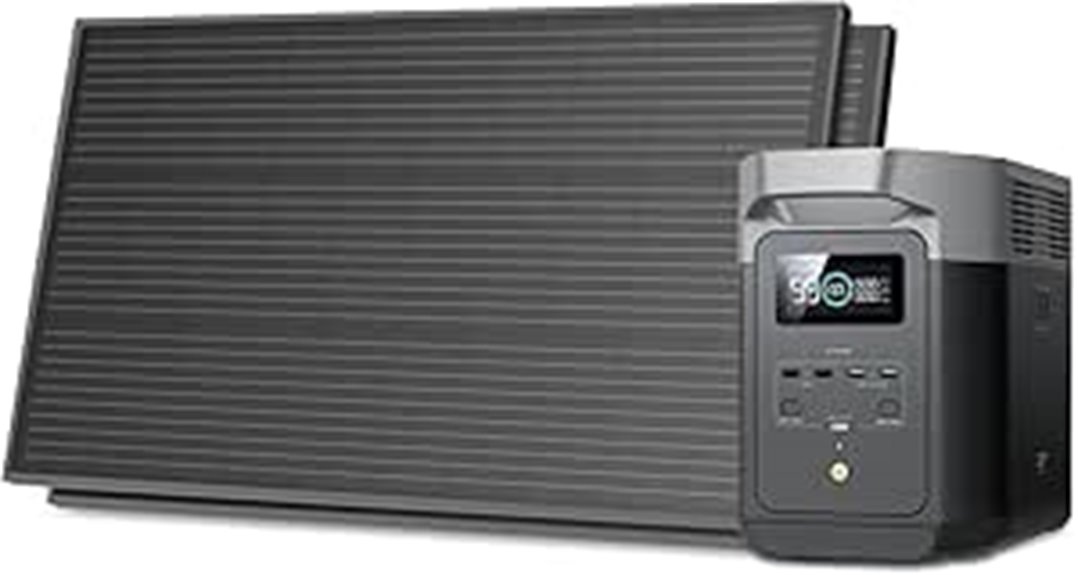
When power outages strike, relying on a portable energy source becomes essential, especially for maintaining home heating. The EF ECOFLOW DELTA 2 portable power station with two 100W solar panels offers a reliable solution. Its 1024Wh LFP battery provides enough capacity to power multiple devices, with a 1800W continuous output and surge up to 2700W. Charging is quick—about 5 hours with solar panels—and it’s compatible with additional panels for faster recharge. Its durable, long-lasting battery guarantees dependable performance during emergencies. Plus, its portability and ability to support nearly all appliances make it perfect for home backup, camping, or outdoor use.
Best For: households, campers, and outdoor enthusiasts seeking reliable, portable backup power for home, camping, or emergency situations.
Pros:
- High-capacity 1024Wh LFP battery ensures long-lasting power and durability.
- Fast solar charging in about 5 hours with two panels, with expandability options for quicker recharging.
- Supports up to 15 devices simultaneously, making it versatile for various appliances and needs.
Cons:
- Solar panels and DELTA 2 power station are shipped separately, requiring additional coordination.
- The maximum solar input may limit rapid recharging if more panels are not added.
- Slightly heavier compared to smaller portable power units, which may affect portability for some users.
Grill Boss Dual Fuel Camp Stove with 4 Butane Canisters
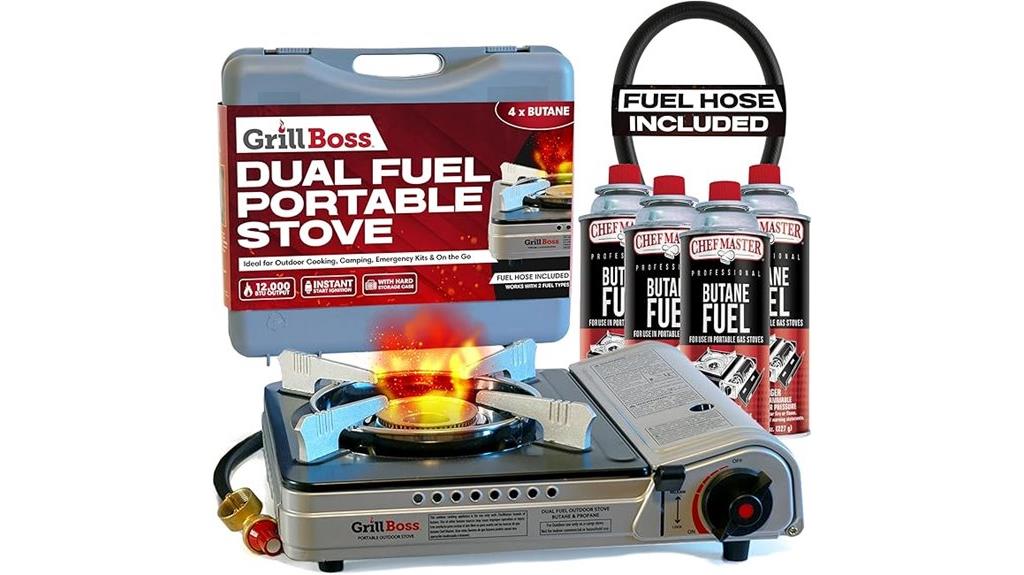
The Grill Boss Dual Fuel Camp Stove is an excellent choice for anyone seeking portable, reliable heat during power outages or outdoor adventures. It comes with four 8 oz butane canisters, offering a 12,000 BTU output for quick and efficient cooking. Compatible with both butane and propane cylinders, it features an easy-to-use fuel adapter for switching fuels seamlessly. Its lightweight, compact design makes it perfect for camping, tailgating, or emergency prep. Safety is a priority, with automatic shutoff and secure setup. The automatic Piezo ignition ensures instant lighting, so you can focus on staying warm and cooking without hassle.
Best For: outdoor enthusiasts, campers, and emergency preparedness individuals seeking a portable, reliable cooking solution with versatile fuel options.
Pros:
- Compatible with both butane and propane cylinders for flexible fueling options
- Compact and lightweight design for easy transport and storage
- Automatic Piezo ignition provides quick, hassle-free lighting in all outdoor conditions
Cons:
- Propane canister not included, requiring additional purchase
- Requires proper setup and maintenance for safe operation
- Limited to 8 oz butane canisters, which may need frequent replacement during extended use
Portable Kerosene Stove for Camping and Outdoor Cooking
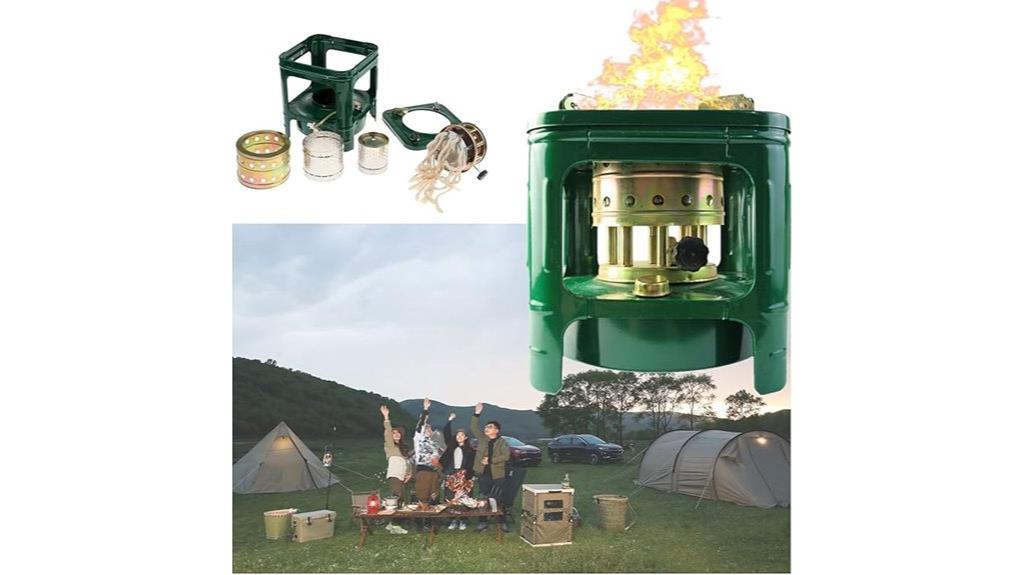
A portable kerosene stove offers a reliable heating and cooking solution when electricity isn’t available, making it ideal for camping, outdoor adventures, or emergency situations. It measures about 17.5×18cm, weighs around 0.72kg, and is made of durable wrought iron. With 8 cotton wick burners, it burns kerosene, diesel, or alcohol for 4–5 hours each. Its compact design supports 2–3 people, perfect for tents, gardens, or balconies. Safe and easy to operate, it requires careful refueling, proper ventilation, and attention to safety precautions. Lightweight and versatile, it’s a practical choice for non-electric heating and outdoor cooking needs.
Best For: outdoor enthusiasts, campers, and emergency preparedness individuals seeking a reliable, portable heating and cooking solution without electricity.
Pros:
- Compact and lightweight design for easy transport and storage
- Durable wrought iron construction ensures stability and longevity
- Long burn time of 4–5 hours per fill supports extended use in outdoor settings
Cons:
- Requires careful handling during refueling to avoid spills or leaks
- Not suitable for prolonged indoor use without proper ventilation
- Fuel restrictions (no gasoline) limit certain fuel options and may require additional planning
BLUETTI AC200PL Solar Generator with 350W Solar Panel
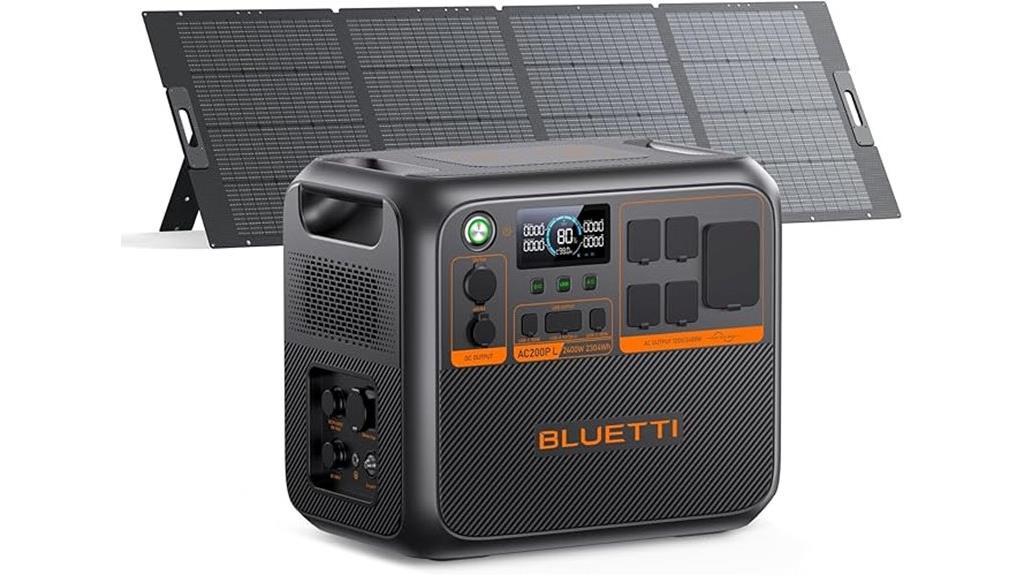
If you’re looking for a reliable backup power source during power outages, the BLUETTI AC200PL solar generator stands out with its massive 2304Wh LiFePO4 battery that can be expanded up to 8448Wh. It features four 2400W AC outlets, a TT30 RV port, and multiple USB and DC outputs, making it versatile for various devices. Charging is quick, with options including solar panels, AC, and car adapters—full recharge in about an hour via AC. Designed for durability, it boasts a 10-year lifespan and over 3000 cycles, ensuring reliable power during emergencies, camping, or outdoor activities. Weighing 72 pounds, it’s portable enough for most outdoor uses.
Best For: outdoor enthusiasts, campers, and households seeking a reliable, portable backup power source during outages and outdoor activities.
Pros:
- Large 2304Wh LiFePO4 battery with expandable capacity up to 8448Wh for versatile power needs
- Multiple outlets including four 2400W AC ports, USB-C, USB-A, and RV port for powering various devices
- Fast recharging options with full recharge in about an hour via AC and up to 3.8 hours with solar input
Cons:
- Heavy at 72 pounds, which may be less portable for some users
- Higher price point compared to smaller or less capable portable generators
- Requires separate purchase of solar panels for solar charging functionality
Factors to Consider When Choosing Emergency Home Heating Options Without Power

When selecting emergency heating options without power, I consider safety first to prevent accidents or hazards. I also evaluate fuel types to guarantee compatibility with my home setup and look at space heating capacity to meet my needs. Additionally, I keep portability and ease of use in mind so I can easily operate and store the system when needed.
Safety Considerations
Choosing an emergency home heating option without power requires careful attention to safety features that protect you and your family. Proper ventilation is essential when using non-electric devices to prevent dangerous fumes and carbon monoxide buildup. Make sure the heater has safety features like tip-over switches, automatic shut-off, and overheat protection to reduce fire risks. Only use equipment designed specifically for indoor or outdoor use; never repurpose outdoor heaters indoors, as this can cause fire and health hazards. Follow the manufacturer’s instructions carefully for fuel storage, handling, and operation to avoid leaks, spills, or explosions. Regularly inspect and maintain your heating devices to ensure all safety mechanisms work correctly, helping prevent malfunctions and ensuring your safety during emergencies.
Fuel Type Compatibility
Selecting an emergency heater that matches your available fuel sources is crucial for safe and effective operation. First, identify which fuels you have—kerosene, propane, natural gas, or alcohol—and choose a heater compatible with those. Some units support multiple fuel types, offering flexibility if your supplies change. Always check if the fuel capacity suits your expected usage to ensure consistent warmth during prolonged outages. Additionally, verify that the heater’s design allows safe operation with your chosen fuel, including proper ventilation and handling procedures. Be aware of safety precautions specific to each fuel, such as proper storage and ignition methods, to prevent accidents. Matching your heater to your fuel sources guarantees a reliable, safe, and efficient heating solution during emergencies.
Space Heating Capacity
Making sure your heater can effectively warm the space depends on understanding its heating capacity. To do this, check the unit’s coverage area—most small to medium heaters are rated for 200 to 450 square feet. The BTU output is also essential; for spaces up to 1,000 square feet, look for heaters with 10,000 to 23,500 BTUs. Confirm the device can operate independently of electricity, like kerosene or propane models, so it works during outages. Consider the thermal output—radiant or convection heat—to see how evenly warmth will distribute. In the end, match the heater’s capacity with your space’s insulation and ambient conditions to prevent wasting fuel and to keep the temperature comfortable and consistent.
Portability and Storage
When it comes to emergency home heating without power, portability and storage are key factors to contemplate. Portable heaters generally weigh between 7.6 and 21.8 pounds, making them easy to move and store in small spaces. Compact designs, like wall outlet or personal space heaters, save space and can be tucked away in closets or cabinets when not in use. Fuel-based units, such as kerosene or propane heaters, often feature handles or wheels, allowing for quick relocation during an outage. Foldable solar panels and modular power stations provide convenient storage options, stacking or packing tightly for emergency prep. Lightweight heaters and power sources can be stored in carrying cases or bins, ensuring rapid deployment and minimal storage footprint when not needed.
Ease of Use
Choosing an emergency heating option that’s easy to operate can make all the difference during a power outage. I look for devices with simple, intuitive controls like push-button starts or manual ignition, so I can get them running quickly. Minimal assembly or adjustments are essential, as stress can lead to mistakes, and I want to avoid that. Safety features like automatic shut-off and tip-over protection give me peace of mind, knowing the unit is less likely to cause accidents. I prefer solutions that don’t rely on electricity, such as kerosene, propane, or canned heat, so I can use them reliably without power. Additionally, lightweight and portable options help me deploy the heater swiftly and easily, ensuring I stay warm when it matters most.
Safety Precautions
Safety is the top priority when selecting emergency home heating options without power, especially since many devices produce fumes or involve open flames. Proper ventilation is essential to prevent dangerous carbon monoxide buildup, so I always verify windows or vents are open when using indoor heaters that emit fumes. Installing carbon monoxide detectors and testing them regularly gives me peace of mind, alerting me to potential gas leaks. I also keep combustible materials away from heat sources and stick to recommended clearance zones. Following manufacturer instructions carefully helps me operate and maintain equipment safely. Ultimately, I have a plan for safe power alternatives and avoid using open flames or unapproved heating methods indoors, reducing fire risks during emergencies. These precautions protect my home and loved ones in critical moments.
Frequently Asked Questions
How Safe Are Kerosene Heaters for Indoor Use During Power Outages?
Kerosene heaters can be safe for indoor use during power outages if you follow strict safety guidelines. I always guarantee proper ventilation to prevent carbon monoxide buildup and keep the heater on a stable, non-flammable surface. I also use high-quality fuel and regularly maintain the unit. That said, I’m cautious and never leave it unattended, because safety is my top priority when heating with kerosene indoors.
Can Portable Solar Generators Power Home Heating Devices Effectively?
Like a lighthouse guiding ships through storms, a portable solar generator can power home heating devices, but with limits. I’ve found they’re effective for small, energy-efficient heaters, especially in moderate cold. However, for larger heating systems or extreme cold, they might not provide enough power. Think of it as a helpful beacon—great for supplementing warmth, but not a full replacement during harsh winter nights.
What Are the Best Fuel Types for Emergency Home Heaters Without Power?
The best fuel types for emergency home heaters without power are propane, kerosene, and wood. Propane is convenient and burns clean, making it a popular choice. Kerosene offers high heat output but requires proper ventilation. Wood is a reliable, renewable option if you have a safe fireplace or stove. I recommend having a mix of these fuels on hand to make certain you stay warm during power outages.
How Long Do Portable Inverter Generators Typically Last During Outages?
During outages, a portable inverter generator can usually run between 8 to 12 hours on a full tank, giving you a full night’s worth of power. It’s like having a reliable heartbeat that sustains your essentials until the power returns. The actual duration depends on the load you place on it and the capacity of its fuel tank. Keeping it fueled and well-maintained guarantees it’s ready when you need it most.
Are There Eco-Friendly Options for Non-Electric Emergency Home Heating?
Yes, there are eco-friendly options for non-electric emergency home heating. I recommend using biomass stoves, which burn sustainably sourced wood pellets, or solar heaters that harness sunlight to generate warmth. These options reduce reliance on fossil fuels and minimize environmental impact. Plus, they can be effective during power outages, keeping your home warm while being mindful of the planet. Just make certain proper ventilation and safety measures when using any alternative heating method.
Conclusion
When the lights go out, I picture myself wrapped in a warm blanket, the flickering glow of a portable heater or the crackling sound of a kerosene stove filling my home with cozy warmth. With the right emergency heating, I can turn an icy, dark night into a snug refuge. No matter which option you choose, staying warm means you’re also staying safe and comfortable, even when the power’s gone.









